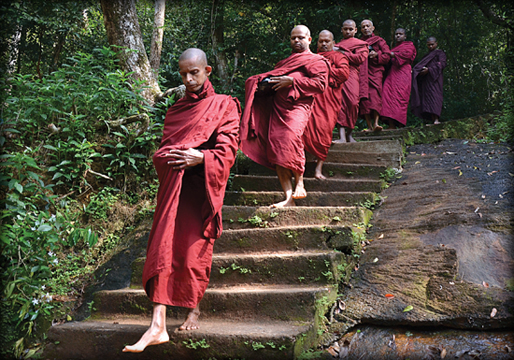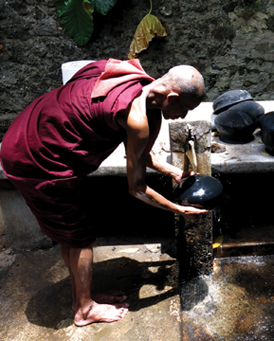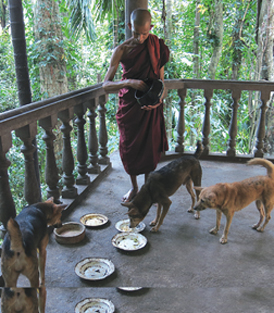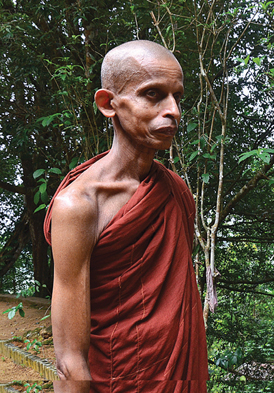A life spent in meditation
Conversation with a monastic Bhikkhu at Bodhinagala
forest hermitage:
Story and pictures by Mahil Wijesinghe
Clad in deep brown robes the monastic Bhikkhus walk in single file,
composed, silent, and sedate. There is beauty in this simple task, a
kind of tranquility and harmony that is in sync with the forest
surroundings. With alms bowl in hand, the monks make their way towards
the ‘Dana Salawa’ (alms hall) where the devotees wait in postures of
piety, head bowed, hands clasped.
|

Ven. Thibbotugoda
Rahula, in front, walking along with
other Bhikkhus of Pindapatha under the
forest canopy for midday meal to the
alms hall in Bodhinagala hermitage. |
The scene is near surreal. Some of the male devotees wash the feet of
the Bhikkhus while the others serve the ‘dana’ all the while chanting
“Sadu, Sadu.”
In silent procession, the Bhikkhus retire to another alms hall a
little distance away, sit down and prepare to partake of the food they
just received. A sole brown robed figure stays behind in the ‘Dana
Salawa’ to confer merit on the devotees who served alms.
Daily routine
This is a moment in the daily routine of the Bhikkhus of the
Bodhinagala forest hermitage.
Nestling on the bank of the Kalu Ganga, near the Dobagaskanda hill in
the outskirts of Ingiriya, the Bodhinagala hermitage lies beneath the
leafy canopy of a rain forest reservation extending over 347 hectares.
The natural rain forest shields the hermitage from the outside world,
providing picture perfect serenity for the meditating Bhikkhus.
When I was a school boy in Botalegama, an adjoining village of
Dombagaskanda, I used to hear the reverberation of Hevissi sound from
the Bodhinagala forest hermitage in the early hours of the morning and
evening. In those days, I had a fixed lens small camera and used to
visit the hermitage to shoot the daily life in the hermitage. Each time
I visited the hermitage I used to see one Bhikkhu, slender in build and
fair in complexion, always walking in front of the group of Bhikkhus
when they moved towards the alms hall. That was in the 1980s. However,
during my recent visit to the hermitage, I decided to talk to this lone
Bhikkhu and find out more about his life.
Up a stone pathway is his kuti (hut), furnished with a narrow bed,
table and a low stool. The walls are adorned with pictures of the
Buddha. The Kuti is surrounded by huge trees, which provide both ample
shade and a sense of absolute calm. The silence of this serene scene is
occasionally broken by the sound of a hornbill or monkey.
The Bhikkhu, 67-year-old Ven. Thibbotugoda Rahula, who has been
living in the Bodhinagala forest hermitage since 1966, is the most
senior resident of the hermitage. Welcoming me to his humble abode, he
recounts the extraordinary story of journey to the hermitage and a life
spent in meditation.
History
The history of the
Bodhinagala forest hermitage goes back to the early 1950s.
Ven. Olaboduwe Sri Revatha Dammakirthi Thera, a pious
Buddhist monk and the principal of the Dharmadeepa
Vippassana Piriwena in Kaluwamodara in Aluthgama was the
founder of the hermitage. He came to Ingiriya to observe Vas
on the invitation of devotees in the Raigam Korale. After
the Vas season was over, the Bhikkhu prepared to go back,
but the devotees persuaded him to stay permanently. The
Bhikkhu with the help of a few villagers visited the thick
forest of Dombagaskanda and at first sight, realized it was
ideal for a forest hermitage.
The villagers and devotees
in the Raigam Korale constructed the Kutis and other
buildings in the Dobagaskanda forest and on June 4, 1955,
the complete hermitage of Bodhinagala was offered to the
Sanga. Initially, five Bhikkhus lived in the small Kuti
(hut) in five acres of forest and later, it was expanded to
50 acres. Today, this hermitage has numerous constructions
including Kutis, meditative walkways and medical halls,
linked together and developed as a reputed forest hermitage
in the country with around 15 resident Bhikkhus. |
Born to a Buddhist farming family in Thibbotugoda in Horana in 1948,
Somawardena Kaluarachchi, as he was then known, had his primary
education at the Welikala Primary School in Pokunuwita. From there he
joined Sri Palee Collage, Horana, and continued till ordinary level
education. When Somawardena Kaluarachchi was a small boy, he used to
frequently visit his grandmother’s house next door, because of the
plethora of books available there. Among the books he most liked to read
were Buddhist Jathaka stories.
|

Ven. Thibbotugoda Rahula washes his bowl after the midday
meal (Dana) |
|

Ven. Thibbotugoda Rahula feeds dogs at the hermitage. |
|

Ven. Thibbotugoda Rahula in a pensive mood at his Kuti. |
Being the only son in a family eight, his father gave everything for
him. They had large acres of paddy lands, so they were fairly well to
do. He went to school by bullock-cart owned by his father.
He studied up to the ordinary level, and dropped out, opting to study
the Buddhist doctrine and enter the Bhikkhuhood. He had always
associated with the village temple where he had learnt a lot about
Buddhism.
“Soon I began to read more Buddhist books and I found myself being
interested in the forest hermitage in Ingiriya. One day, I visited the
hermitage with my father and met the Chief Monk. I told him I would like
to enter the Bhikkhuhood. My parent gave permission for me to be a
Bhikkhu,” once called Somawardena recalls while sitting on a stone slab
in front of his humble Kuti.
His dreams were realized in 1966, when at the age of 19 he was
ordained as Thibbotugoda Rahula under the guidance of Ven. Olaboduwe
Dammakirthi Thera, the Chief Incumbent of the Bodhinagala hermitage. He
lived in the hermitage as a samanera for several years, studying
meditation practices with five Bhikkhus, before he attained Upasampadha
in 1971 at the Asgiriya Temple in Kandy.
“Soon I became a Bhikkhu of the hermitage. I was provided everything
I wanted as a Bhikkhu. Devotees gifted robes. My family members and
relatives come to see me time to time. Even today, my sisters who are
old now, visit me regularly,” he says.
Organized timetable
Since becoming a monastic Bhikkhu, Ven. Rahula has an organized
timetable for daily routine in for meditation, study and worship, which
usually lasts until 10 p.m. insight meditation, usually sitting still
last for one and a half to two hours, twice a day. The daily program
also includes a few domestic duties, with priority being given to
personal cleanliness. So the hermitage timetable includes a daily bath,
which is a must unless otherwise indisposed.
In the past forty years, Ven. Rahula has spent his monastic life
practicing insight meditation, which is one of the most widely use
Anapanasathi, the concentration on rhythmic inhalation and exhalation of
breath.
How to get there
To reach the Bodhinagala
forest hermitage, one has to travel on the
Panadura-Ratnapura (A-8) highway, turn left at the Aduragala
junction and travel a further 2 kilometers along the minor
road, which leads to the Kalu Ganga. Before coming to the
river, the road branches off to the left and continues for
another 1.5 kilometers and comes to an area where it reaches
the foot of Dombagaskanda. Although the road up to the hill
is motorable, it’s better to get off one’s vehicle at this
point and walk through the forest. |
“My day starts at 4.a.m. At 6.00 a.m. I walk (Pindapatha) for
breakfast and around 9.30 a.m. have a bath and get ready for the midday
meal Pindapatha, which is at 10.a.m at the alms hall. All the Bhikkhus
in the hermitage gather in the upper alms hall from where we go
pindapatha to the lower alms hall, which is a little distance away,
where devotees offer alms to our begging bowls. We return to the upper
alms hall and partake in our midday meal with all the Bhikkhus. After
Dana, we rest for a little while and read the Dhamma books, which are
gifts of the devotees,” he says, elaborating on the daily schedule,
which rarely varies.
Ven. Rahula has been in charge of the Dhamma Chetiya in the hermitage
for several years and he is responsible for holding the daily Buddha
Puja. “At around 7.00 p.m. the devotees, who come to offer alms the
following day, take part in this special Buddha Puja called ‘Buddha
Watha’, which takes about one hour. After finishing the day’s work I go
to sleep at around 10.00 p.m.,” he explains.
So do the monastic monks ever venture into the outside world? Being
Vipassanadhura monks, Ven. Rahula says he and his fellow Bhikkhus are
mainly in contemplation, and that with Vippassana Bhavana, insight
meditation, being the dominant and central theme, they live mostly in
secluded forest hermitage complexes call Aranya.
They do not take part to any religious activities in outside of the
hermitage but if someone invites them to preach a sermon they will
accept it. |

